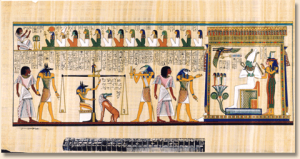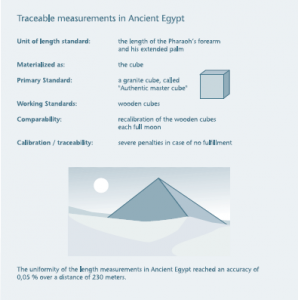
 Length and mass were the earliest measurements made by mankind. According to some historians, the oldest standard of measurement of mass that can be traced is the bega, a unit of mass used in Egypt in 7000 to 8000 B.C. it is believed that the weights were probably seeds, beans or grains, which were used in conjunction with a rudimentary balance for trading. An example of this is the carat. This was the seed of the coral tree and was called quirat in Arabic. It has now been standardized as 0.2 grams (g) and the word quirat has been corrupted to the present day carat.
Length and mass were the earliest measurements made by mankind. According to some historians, the oldest standard of measurement of mass that can be traced is the bega, a unit of mass used in Egypt in 7000 to 8000 B.C. it is believed that the weights were probably seeds, beans or grains, which were used in conjunction with a rudimentary balance for trading. An example of this is the carat. This was the seed of the coral tree and was called quirat in Arabic. It has now been standardized as 0.2 grams (g) and the word quirat has been corrupted to the present day carat.
 The early length measurements were usually based on parts of the body of the king (the pharaoh). The measurement of length known as a cubit was probably conceived between 2800 and 2300 B.C. in Egypt. The word came from the latin cubitum, meaning elbow, because the unit represented the length of a man’s forearm from his elbow to the tip of his outstretched middle finger. The cubit was later standardized in a royal master cubit made of black marble (about 52 centimetres (cm) long). This standard cubit was divided into 28 digits (roughly a finger width), which could be further divided into fractional parts, the smallest of these being only just over a millimeter (mm).
The early length measurements were usually based on parts of the body of the king (the pharaoh). The measurement of length known as a cubit was probably conceived between 2800 and 2300 B.C. in Egypt. The word came from the latin cubitum, meaning elbow, because the unit represented the length of a man’s forearm from his elbow to the tip of his outstretched middle finger. The cubit was later standardized in a royal master cubit made of black marble (about 52 centimetres (cm) long). This standard cubit was divided into 28 digits (roughly a finger width), which could be further divided into fractional parts, the smallest of these being only just over a millimeter (mm).
 For volume measurement, containers made out of gourds or clay were filled with seeds of plants. These seeds were then counted to measure the volume. The ancient Egyptians had a variety of volume measures. The most important of these was called the hen, which was about 477 cm3. The Syrians, Phoenicians, Babylonians and Persians also had their own units for volume measure.
For volume measurement, containers made out of gourds or clay were filled with seeds of plants. These seeds were then counted to measure the volume. The ancient Egyptians had a variety of volume measures. The most important of these was called the hen, which was about 477 cm3. The Syrians, Phoenicians, Babylonians and Persians also had their own units for volume measure.
In the years following the early days of measurement, the Romans introduced measurements called the uncia and the mille. The uncia was the width of a thumb and the mille was the distance a roman soldier covered by walking 1,000 steps.
An Anglo-Saxon system of measurement was originally followed in England until the Norman Conquest in 1066. At that time, length was the main unit of measurement being used. For short lengths, barleycorn and the inch were used as units. The inch was originally defined as 3 grains of barleycorn laid end to end, or as the width of a thumb. It is interesting to note that in many languages, the word for inch was also the word for thumb. For measuring longer lengths, such as for measuring land, the gyrd (or rod) was used. This was equal to 20 “natural feet”.
Before the Norman Conquest, volume measures such as the amber, mitta, sester and coomb were used in England. It is possible that the amber was close in volume to the Roman amphora of 6 gallons, but these early measures are not known to any level of accuracy and some of them varied with the product being measured. The English system of weights and measures was influenced greatly by the Romans and, through them, the Greeks. The roman-based measurement system was introduced after the Romans conquered England, from the middle of the eleventh century. However, in England units of measurement were not properly standardized until the thirteenth century. Even then, three different measures of a gallon (for ale, wine and corn) were standardized only in 1824.
The foot-pound-second system of units was a scheme for measuring dimensional and material quantities. The fundamental units were the foot (ft) for length, the pound (lb) for weight and the second (s) for time.
One foot represents a length of 12 inches; it was originally approximately equal to three hand widths or two thirds of a cubit. Today, however, a foot is considered to be 0.3048 metres, where the metre (m) is the fundamental unit of length in the international system of units.
One pound is the force that produces an acceleration of 32.1740 ft per second squared
(32.1740 ft/s2) when applied against a known standard mass. The acceleration of
32.1740 ft/s2 is approximately the value of the earth’s gravitational acceleration at a latitude of 45 degrees north.
As the years went by, the foot-pound-second system of measurement slowly lost ground against the metric system. Although the United Kingdom of Great Britain and Northern Ireland and the United States of America were following the FBS system, they found that more and more countries were adopting the metric system. This started creating technical problems for them in the field of international trade. Gradually, these two States also decided to adopt the metric system. However, although adopted in law, a portion of trade and industry in both these States still follows the old foot-pound-second system.
In 1790, in the midst of the French Revolution, the National Assembly of France requested the french academy of sciences to “deduce an invariable standard for all the measures and all the weights”.
The unit of length decided upon was the metre. This name was derived from the Greek word metron, meaning a measure. The metre was defined as being one ten-millionth part of a quarter of the earth’s circumference. Measures for capacity (volume) and mass were to be derived from the unit of length. Thus, a system evolved in which the basic units of the system were related to each other. It was also decided that the larger and smaller versions of each unit were to be created by multiplying or dividing the basic units by 10 and its powers. Calculations in the metric system could therefore be performed simply by shifting the decimal point. Thus, the metric system was a “base-10” or decimal system. The weight of three cubic decimetres of distilled water at 4°C was adopted as the kilogram (kg). The litre was defined in terms of the kilogram.
The metric system, however, was not initially accepted with much enthusiasm.
However, after France made its use compulsory in 1840, adoption by other States occurred steadily. The standardized character and decimal features of the metric system made it well suited to scientific and engineering work. Consequently, by an act of Congress in 1866, the United States made it “lawful throughout the United States of America to employ the weights and measures of the metric system in all contracts, dealings or court proceedings.”
In 1875, an international treaty—the Convention of the Metre—set up well-defined metric standards for length and mass and established a permanent machinery to recommend and adopt further refinements in the metric system. A total of 17 States, including the United States, signed the Convention, which is also known as the Metre Convention. By 1900, a total of 35 States, including the major nations of continental Europe and most of South America, had officially accepted the metric system.
In the metric system, initially the centimetre was the unit of length while the gram was the unit of mass and the second was the unit of time. Thus, the early metric system was also known as the CGS system of units. For industry and trade, however, the units were MKS, standing for metre, kilogram and second.
The Metre Convention established the General Conference on Weights and Measures as the permanent machinery to maintain and improve upon the metric system. The Conference is an assembly of delegates from all the States that have signed the Metre Convention. The first meeting of the Conference was held in 1889 and it continues to be held once every four to six years.
The constant endeavours of the General Conference on Weights and Measures to improve upon the metric system resulted in the addition of further units of measurement. The ninth Conference, held in 1948, added the ampere (a) as the fourth unit in the metric system, which then came to be known as MKSA system. In 1954, the tenth Conference defined two more units, the kelvin (k) as the base unit of thermodynamic temperature and the candela (cd) as the base unit of luminous intensity.
Thus, the era of the International System of Units comprising the metre, kilogram, second, ampere, kelvin and candela began.
The eleventh Conference, held in 1960, redefined the metre in terms of wavelengths of light. It also gave the new metric system the official symbol of SI, taken from the French (Système international d’ unités), as the International System of Units of measurement.
Finally, the fourteenth Conference, held in 1971, added a seventh base SI unit, the mole (mol), as the unit of the amount of substance. Thus, the present modern version of the SI metric system has seven base units, from which all other units of measurement are derived. The seven base units are defined in chapter 3 under the section entitled “Absolute standards”.
With scientific and technological advancement over the years, the definition of these seven base units has been changing. Today, only the kilogram remains a unit based on an artefact or a physical object, the prototype kilogram kept near Paris. All the other units are defined in terms of wavelength and time, which can be measured and reproduced with a high degree of accuracy and precision.
Source: role of measurement and calibration
UNITED NATIONS
INDUSTRIAL DEVELOPMENT ORGANIZATION (UNIDO)